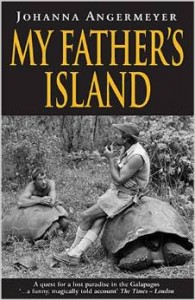 When we here at WoWasis toured the Galápagos Islands recently, we were frankly surprised at the relative modernity of the town or Puerto Ayora on Isla Santa Cruz. The island is replete with electricity, air conditioning, internet, and flush toilets (like the rest of Ecuador, though, used toilet paper is placed in a basket and not flushed). The name Angermeyer figures prominently in this town, derived from four brothers of that name who arrived here from Germany in 1935. Johanna Angermeyer, author of My Father’s Island: A Galápagos Quest (1989, ISBN 0-670-82732-0) is the daughter of one of them, Johannes Angermeyer.
When we here at WoWasis toured the Galápagos Islands recently, we were frankly surprised at the relative modernity of the town or Puerto Ayora on Isla Santa Cruz. The island is replete with electricity, air conditioning, internet, and flush toilets (like the rest of Ecuador, though, used toilet paper is placed in a basket and not flushed). The name Angermeyer figures prominently in this town, derived from four brothers of that name who arrived here from Germany in 1935. Johanna Angermeyer, author of My Father’s Island: A Galápagos Quest (1989, ISBN 0-670-82732-0) is the daughter of one of them, Johannes Angermeyer.
The book is a fascinating tale of the author growing up in Lincoln, Nebraska, where she was born, Riverside, California, Quito, Ecuador, and the Galápagos. She spent considerable time in all three places. It’s also her personal quest to build a family history, and thank goodness she includes a family tree to assist the reader in fathoming its complexity. From a familial perspective, the tale she weaves involves five brothers who set off on a quest to flee the Nazi regime in the mid-1930s. The remote Galápagos Islands was their goal, and four of them reached it and took up residence on Isla Santa Cruz, building everything from scratch and living a life that Angermeyer describes as being right out of Robinson Crusoe. Johanna, whose biological father Johannes had died years earlier, finally made it to the island for her first visit when she was thirteen years old. She fell in love with it, spent summers there while she attended school in Quito, and eventually moved there permanently in 1971. Far from the creature comforts so easily found there today, the author lived a hard-scrabble existence, as recounted in this passage describing one of her pre-residence visits:
In the tropics, without refrigeration, the safest place for meat or fish was in your belly… Each household normally knew through the ‘bajucco’ (a tenacious vine) just when another hunter or fisherman was going out. In between times the children net-fished on the beach, then distributed mullet from house to house. When no one went out, we ate rice and avocado, when available, or tinned tuna, or bread if one had an oven. When someone got hungry, they took half the day off and took a gun into the bush. Sighting of goats were reported. Sometimes big bucks followed the house-goats home and were shot before breakfast from a bedroom window.
(One) afternoon [sister] Mary said my hair smelled like a stagnant goldfish bowl and it was decided we should take our laundry and dirty bodies over to Pelican Bay for washing. Borrowing the most uncapsizeable and therefore heaviest of Gus’s skiffs, we took turns rowing tight circles and zigzags across the bay, my sister, as usual, telling us what to do. But it was Mother who remembered how to wash clothes, scooping up brackish water with a bent rusty can from the same crack in the lava she had used all those years ago, lathering the clothes with blue lye soap, rinsing them in a bucket and hanging them over bushes to dry. It was back-aching work. The lye burned our eyes if we brushed the perspiration from our face with our hands. The soap did not rinse out thoroughly and our perverse dying-bushes brushed the clean clothes into the red dust every time a breeze told them to. Shampoo was so expensive that we washed our hair the islanders’ way; squashing ripe avocados on each other’s heads, sprinkling soap flakes over this and creating a pale guacamole lather. The oil was so rich that, once rinsed, our hair shone and our skin felt as soft as if we’d used the costliest soap.
One of the book’s great personal celebrations is described when a new privy is built.
 In addition to being a fascinating story of a settler family in a beautiful, remote, and often unforgiving environment, the book has tremendous value for today’s visitor. Driving on the road from the Isla Baltra ferry and walking through Puerto Ayora, it’s difficult to imagine how challenging it was for the early settlers, and Angermeyer’s book brings it all into focus, bringing the reader into her personal world as well as that of her uncles, who were profiled in magazines and adventure television shows of the era.
In addition to being a fascinating story of a settler family in a beautiful, remote, and often unforgiving environment, the book has tremendous value for today’s visitor. Driving on the road from the Isla Baltra ferry and walking through Puerto Ayora, it’s difficult to imagine how challenging it was for the early settlers, and Angermeyer’s book brings it all into focus, bringing the reader into her personal world as well as that of her uncles, who were profiled in magazines and adventure television shows of the era.
Angermeyer does leave out a few important details of her own life, including her marriage and the fact that they’d lost their infant daughter. Part of her recovery over the tragedy was in recording interviews on tape with many of the early settlers. Those interviews contributed to this book, which was published in 1989. After living in the Galápagos for twenty years, she and her husband moved to England, becoming involved in conservation and animal welfare.
Although the book is twenty-five years old now, it has lost none of its luster. Especially for the visitor coming to Isla Santa Cruz for the first time, it’s an eye-opener and worth bringing along for the trip. For readers who have never been there, it serves as a temptation to travel there. And it will bring back memories for those that have, and who may very well have a new perspective on what they’ve seen and what they’ve missed.
Leave a Reply